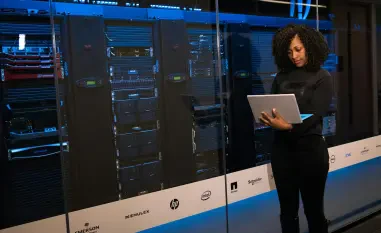In the intricate and high-stakes world of cybersecurity, few adversaries pose as grave a threat to critical industries as UNC1549, a suspected Iran-nexus threat actor with a razor-sharp focus on the aerospace, aviation, and defense sectors. Mandiant’s latest report, delving into the group’s tactics, tools, and malware, paints a chilling picture of an espionage-driven entity that thrives on precision and persistence. Operating with a level of sophistication rarely seen, UNC1549 has mastered the art of breaching even the most fortified environments, targeting organizations that safeguard sensitive intellectual property and national security data. Their campaigns, active since late 2023 and projected to evolve over the coming years, reveal a calculated approach that exploits both technological gaps and human vulnerabilities, making them a formidable foe in the cyber realm.
The aerospace and defense industries, often at the forefront of innovation and geopolitical strategy, are prime targets for such state-aligned actors. UNC1549’s ability to penetrate these sectors through trusted third-party relationships and meticulously crafted phishing schemes underscores the fragility of interconnected supply chains. What makes this group particularly dangerous is their relentless focus on long-term access, embedding themselves within networks using dormant backdoors and stealthy communication channels. Mandiant’s updated analysis since mid-2024 builds on earlier findings, highlighting how this threat actor continuously adapts to countermeasures, ensuring their espionage goals are met with chilling efficiency. This persistent and evolving danger serves as a stark reminder of the challenges faced by industries critical to global security.
Initial Access Strategies
Exploiting Trusted Relationships
UNC1549 has honed a particularly insidious method for breaching high-security networks by exploiting trusted third-party relationships, a tactic that circumvents the robust defenses of primary targets in the aerospace and defense sectors. By compromising credentials from vendors, contractors, or partners—entities often with weaker security postures—this group gains legitimate access to services like Citrix, VMware, and Azure Virtual Desktop. Once authenticated, they skillfully break out of virtualized environments to infiltrate broader network segments, exploiting the inherent trust between organizations and their external collaborators. This approach proves especially effective against defense contractors, where direct attacks might fail due to stringent safeguards, but third-party connections offer a less resistant entry point. The strategic foresight in targeting these relationships reveals a deep understanding of supply chain vulnerabilities, allowing UNC1549 to penetrate environments that would otherwise remain impenetrable.
Beyond the initial breach, the exploitation of trusted relationships often serves as a springboard for further expansion within a target’s ecosystem, highlighting a significant vulnerability in interconnected systems. Mandiant’s findings indicate that UNC1549 frequently pivots from compromised third-party accounts to access adjacent systems or related organizations, effectively turning a single point of failure into a cascading threat across an industry. This method not only bypasses traditional perimeter defenses but also complicates attribution, as the use of legitimate credentials masks malicious intent under the guise of routine business operations. Such tactics highlight the critical need for organizations to scrutinize the security practices of their external partners, as a single weak link can jeopardize an entire network. The persistent reliance on this access vector demonstrates UNC1549’s patience and resourcefulness in identifying and exploiting systemic gaps.
Spear-Phishing Campaigns
Another cornerstone of UNC1549’s initial access strategy lies in their highly targeted spear-phishing campaigns, which are crafted with alarming precision to deceive even the most cautious individuals within the aerospace and defense sectors. These emails often masquerade as job opportunities, recruitment offers, or internal communications like password reset requests, tailored specifically to the roles and responsibilities of their intended recipients. By leveraging lures that resonate with the professional context of their targets, such as enticing career prospects, the group increases the likelihood of users clicking on malicious links or downloading infected attachments. This social engineering prowess showcases an acute awareness of human behavior, exploiting trust and curiosity to deliver malware or harvest credentials with devastating effectiveness.
Post-compromise, UNC1549 escalates their phishing efforts by focusing on IT staff and administrators, a move designed to gain higher-privileged access within the network. Using reconnaissance from compromised inboxes, they mimic legitimate internal processes, crafting emails that blend seamlessly with expected communications. This secondary wave of attacks often targets those with elevated permissions, enabling the group to deepen their foothold and expand their control over critical systems. The sophistication of these campaigns, combined with their adaptability to specific organizational workflows, underscores the challenge of defending against such personalized threats. It also emphasizes the urgent need for robust employee training and advanced email filtering solutions to detect and mitigate these deceptive tactics before they can take root.
Advanced Tactics and Techniques
Lateral Movement and Privilege Escalation
Once inside a network, UNC1549 demonstrates remarkable versatility in navigating through victim environments using a range of lateral movement techniques that ensure discreet and effective progression toward high-value assets. Remote Desktop Protocol (RDP) serves as a primary method, often paired with session hijacking to access unlocked browser sessions containing saved credentials. Additionally, tools like PowerShell Remoting and commercial utilities such as Atelier Web Remote Commander (AWRC) facilitate agentless access, enabling reconnaissance and malware deployment without triggering significant alerts. The group also manipulates Microsoft System Center Configuration Manager (SCCM) remote control features to bypass user consent mechanisms, maintaining a low profile while expanding their reach. This blend of native and custom tools reflects a deep understanding of enterprise environments, allowing seamless movement across restricted segments.
Privilege escalation forms a critical phase of UNC1549’s operations, where their expertise in Active Directory exploitation comes to the forefront with chilling precision, showcasing their advanced capabilities. Custom tools like DCSYNCER.SLICK, derived from Mimikatz source code, are deployed to perform DCSync attacks, extracting NTLM password hashes directly from domain controllers. Techniques such as resetting domain controller computer account passwords, though potentially disruptive, grant the necessary replication rights for credential harvesting. Other methods, including Kerberoasting with obfuscated scripts and abusing Active Directory Certificate Services templates for certificate impersonation, further amplify their ability to achieve domain-wide control. This relentless pursuit of elevated access underscores the group’s technical acumen, posing a severe challenge to defenders tasked with securing complex Windows environments.
Defense Evasion and Persistence
Defense evasion remains a critical component of UNC1549’s strategy, employing carefully crafted tactics to conceal their presence and obstruct investigative efforts within compromised networks. After execution, the group routinely deletes utilities and forensic artifacts, such as RDP connection history registry keys, to erase traces of their activities. By leveraging legitimate tools like AD Explorer and native Windows commands for reconnaissance—tasks that mimic routine administrative behavior—they blend malicious actions with expected operations, evading detection by traditional security solutions. This strategic use of trusted utilities not only minimizes their digital footprint but also complicates efforts to distinguish between benign and harmful activities, posing a significant challenge for incident response teams.
Persistence, equally vital to their approach, ensures that UNC1549 can maintain long-term access even in the face of detection and remediation by victims. Dormant backdoors, strategically deployed across networks, remain inactive for months, only activating when needed to reestablish control after a cleanup. Redundant access methods, such as ZEROTIER and NGROK, act as fail-safes, often implemented post-remediation to provide alternative entry points. The use of reverse SSH tunnels for command and control (C2) communications further enhances stealth, as telemetry typically captures only network connections rather than on-host actions. This combination of dormant mechanisms and adaptive access strategies highlights a patient, long-game mentality, ensuring that expulsion from a network is rarely permanent for this adept threat actor.
Custom Malware and Tools
Bespoke Malware Families
UNC1549’s cyber arsenal is distinguished by an array of custom malware families, each meticulously engineered to fulfill specific roles in their espionage campaigns targeting the aerospace and defense sectors. TWOSTROKE, a C++ backdoor, utilizes SSL-encrypted TCP/443 connections for command and control (C2), enabling functions like file manipulation and system information gathering with minimal risk of interception. DEEPROOT, a Linux backdoor written in Golang, supports shell command execution and file operations, catering to diverse environments. Meanwhile, utilities like SIGHTGRAB capture periodic screenshots to expose sensitive on-screen data, and TRUSTTRAP deceives users into entering credentials through fake prompts mimicking legitimate software interfaces. This tailored toolkit, designed for stealth and precision, equips the group with comprehensive control over compromised systems, facilitating their espionage objectives with alarming efficiency.
The diversity and customization of these malware families further amplify UNC1549’s threat, as each payload often carries a unique hash, even within the same victim network, thwarting signature-based detection methods. Other tools, such as LIGHTRAIL and GHOSTLINE, function as tunnelers for C2 communications, frequently leveraging Azure infrastructure to mask their activities under trusted cloud services. POLLBLEND operates as a Windows tunneler with hardcoded C2 servers, while CRASHPAD extracts browser credentials into predetermined files for easy retrieval. This bespoke approach not only demonstrates significant resource investment but also a strategic intent to complicate forensic analysis, ensuring that security teams face an uphill battle in identifying and mitigating these threats. The adaptability of each tool to specific attack phases underscores the group’s sophisticated planning and execution.
Stealthy Deployment Techniques
The deployment of UNC1549’s malware relies heavily on stealthy techniques that exploit inherent software vulnerabilities to maintain a low profile within targeted networks. A favored method, DLL search order hijacking, takes advantage of dependencies in legitimate applications from vendors like VMware, Citrix, FortiGate, Microsoft, and NVIDIA, allowing malicious payloads to execute with SYSTEM-level privileges under the guise of trusted processes. This technique ensures that their tools blend seamlessly into routine operations, evading scrutiny from endpoint detection systems. By embedding their malware within widely used software environments, the group minimizes the likelihood of raising red flags, leveraging the trust organizations place in these applications to sustain their covert presence over extended periods.
Further enhancing their stealth, UNC1549 employs code-signing certificates for some binaries, enabling their malware to bypass application allowlists and other security controls designed to block unauthorized executables. Each payload’s unique hash adds another layer of complexity, rendering traditional antivirus solutions less effective against their ever-evolving toolkit. This meticulous customization, combined with the strategic use of trusted infrastructure like Azure for command-and-control (C2) communications, reflects a deliberate effort to frustrate defenders and investigators alike. The result is a deployment strategy that prioritizes invisibility, allowing the group to operate undetected for prolonged periods while pursuing their espionage goals. Such tactics emphasize the critical need for advanced behavioral analysis and anomaly detection to counter these sophisticated threats.
Strategic Objectives and Implications
Espionage-Driven Data Collection
At the heart of UNC1549’s operations lies a clear espionage-driven motive, with a primary focus on extracting sensitive data that holds immense value for geopolitical and strategic interests within the aerospace and defense sectors. Intellectual property, network documentation, and proprietary communications such as emails are prime targets, often accessed through compromised platforms like Microsoft Teams and SharePoint. Tools like SIGHTGRAB play a crucial role by capturing screenshots of on-screen information, exposing data that might not otherwise be stored in easily accessible files. The group’s methodical approach to data collection ensures that they gather intelligence systematically, prioritizing high-value assets that can provide long-term advantages or competitive insights to their benefactors, aligning with patterns often associated with state-sponsored cyber activities.
Data exfiltration by UNC1549 is executed with a high degree of stealth, typically using reverse SSH tunnels to transfer information directly without staging it within victim environments. This technique obscures the volume and nature of stolen data, as forensic evidence is limited to network connection logs rather than on-host artifacts. The lack of local staging further complicates efforts to assess the full scope of a breach, leaving organizations unaware of the extent of compromised information. This covert exfiltration process, paired with the group’s ability to pivot from primary targets to related entities, amplifies their impact through supply chain attacks. The resulting ripple effect across interconnected industries underscores the broader implications of their espionage, posing a systemic risk to global security frameworks.
Adaptive Operational Security
UNC1549’s operational security has shown significant improvement in recent periods, indicating a maturing threat actor with a proactive stance against detection and investigator actions. The group meticulously minimizes their forensic footprint by deleting utilities and artifacts after execution, ensuring that traces of their presence are erased from compromised systems. Their strategic use of legitimate tools and native Windows commands for reconnaissance allows malicious activities to blend in as routine administrative tasks, seamlessly merging with the background noise of enterprise operations. This adaptive approach not only hinders immediate detection but also complicates long-term attribution efforts, as security teams struggle to piece together fragmented evidence of their intrusions.
Beyond artifact deletion, UNC1549 demonstrates adaptability by responding swiftly to victim remediation efforts, often deploying alternative access methods like ZeroTier and Ngrok as backups to maintain control. Their anticipation of defender actions is evident in the use of dormant backdoors that remain inactive until a strategic moment, bypassing cleanup initiatives. The reliance on trusted cloud infrastructure for command-and-control (C2) communications further masks their activities, leveraging the inherent credibility of platforms like Azure to avoid suspicion. This continuous evolution of tactics, coupled with an unwavering commitment to stealth, positions UNC1549 as a highly resilient adversary. Their ability to stay ahead of countermeasures highlights the pressing need for dynamic, intelligence-driven defense strategies to counter such persistent threats.
Evolving Threat Landscape
Supply Chain Vulnerabilities
The operations of UNC1549 expose critical vulnerabilities in supply chain security, a systemic issue that plagues the aerospace and defense sectors despite their advanced protective measures. By targeting third-party vendors and contractors—often the weaker links in an organization’s ecosystem—the group exploits disparities in security maturity to gain access to primary targets. These breaches are not isolated; they frequently serve as gateways to related entities, transforming a single compromise into a broader industry-wide threat. This cascading effect amplifies the damage potential, as sensitive data and operational integrity are jeopardized across interconnected networks, revealing a fundamental flaw in the trust-based relationships that underpin modern business collaborations.
Addressing these supply chain vulnerabilities requires a paradigm shift in how organizations approach security beyond their immediate boundaries, focusing on broader networks and partnerships. Rigorous vetting of external partners, combined with mandatory security standards and continuous monitoring, becomes essential to mitigate risks posed by less fortified entities. UNC1549’s success in leveraging these connections as entry points serves as a stark warning of the consequences of neglecting third-party defenses. The persistent exploitation of such weaknesses by sophisticated actors necessitates collaborative efforts among industry stakeholders to establish unified security protocols. Without such measures, the interconnected nature of supply chains will continue to be a lucrative target for espionage-driven campaigns, perpetuating a cycle of breaches with far-reaching implications.
Future Defense Considerations
Reflecting on the extensive campaigns orchestrated by UNC1549, it became evident that traditional security measures fell short against their sophisticated blend of technical prowess and strategic patience. Their ability to adapt to remediation efforts, maintain long-term access through dormant backdoors, and exfiltrate data with minimal traces left a lasting impact on the aerospace and defense sectors. The persistent threat they posed underscored the urgent need for a proactive shift in defense strategies, moving beyond reactive responses to anticipate and neutralize such actors before significant damage occurs.
Looking ahead, organizations must prioritize intelligence-driven security frameworks that integrate advanced behavioral analytics and anomaly detection to identify subtle indicators of compromise, ensuring they stay ahead of potential threats. Strengthening supply chain defenses through mandatory security audits and shared threat intelligence among partners can help close gaps exploited by groups like UNC1549. Additionally, investing in employee training to recognize and resist tailored phishing attempts remains a critical line of defense against initial access tactics. By fostering a culture of vigilance and adopting layered security approaches, industries can better prepare for the evolving tactics of state-aligned adversaries, ensuring that past breaches inform stronger, more resilient protections for the future.













